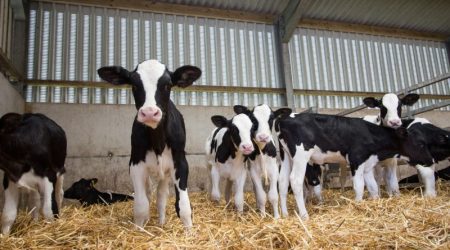
Come weaning time, there’s a seemingly never-ending house of horrors awaiting young calves.
But rather than ghosts and goblins, weaned calves face frightening new surroundings. This can include unfamiliar feed, new water sources, exposure to different cattle and harmful pathogens, plus increased stress. Without proper care, sending a recently weaned calf into the next segment of the cattle industry is like sending a toddler into a haunted house alone.
Calves Embark on a Substantial Endeavor at Weaning
When stockers or feedlots buy weaned calves, they may or may not be purchasing cattle that are well prepared for the next segment of the industry. When I give presentations about nutrition for weaned calves to others in our industry, I always focus on the many risks calves face at weaning. While a weaned calf may weigh three times more than I do, it is a fragile creature. When considering the wellness of weaned calves, I recommend prioritizing three key areas — nutrition, health and stress.
1. Nutrition
At the very basic level, all cattle require water, minerals, vitamins, energy and protein. Weaned calves will benefit from a nutrient-dense starter ration. While calves may only initially eat 1 to 2 pounds of feed a day, it’s crucial they begin receiving nutrients into their bodies. I like to remind cattle producers that flexibility and understanding are key during the earliest weeks of arrival for weaned calves. Likely, there will be groups that are unfamiliar with feed or water troughs. They may have little interest in either.
WARNING: Danger lurks when calves are switched too quickly from a starter to a grower ration. Throughout my time in the industry, I have seen producers immediately increase energy by 30% when making the transition from starter to grower ration. This abrupt switch causes acidosis, which can then cause a domino effect of digestive nightmares. It is crucial to make a gradual transition from starter to grower rations. For instance, if I jump energy by 15%, I’ll cut back feed by 10%. Although the grower ration is higher in energy, dropping the feed intake allows the transition to be made with little change in the rumen.
TIP: Make the starter-to-grower ration transition on a Monday. Cut the delivery back by 10%. If calves were receiving 10 pounds of starter, you’ll now feed 9 pounds of grower ration. If calves clean up the feed in three days, I’ll add another half-pound. Now, they are receiving 9.5 pounds. If they clean that up in three days, I’ll go on up to 10 pounds. A gradual transition is crucial.
In addition to grain, recently weaned calves often have not seen a water trough. Their go-to water sources have been ponds, rivers or creeks. To help familiarize them with a water trough, I have used a few rubber ducks to float in the trough. Calves are curious creatures. Once nosing the ducks, they’ll soon become acquainted with their new water source. You also can add a water pump. Once they hear bubbling water, calves will soon catch on.
Nutrition directly impacts vaccination programs. If weaned calves do not receive adequate minerals and other nutrients, they could be faced with depressed immune response, which affects weight gain long term.
2. Health
By prioritizing nutrition, you can help your calves achieve a full immune response to vaccinations. Among respiratory pathogens that put young calves at risk, Mannheimia haemolytica, infectious bovine rhinotracheitis (IBR), bovine viral diarrhea (BVD) virus Types 1 and 2, and bovine syncytial respiratory virus (BRSV) are primary concerns. Providing vaccines early in life can allow calves to use nutrients for growth and production rather than fighting disease.
3. Stress
Stress is high whether weaned calves enter the grow yard or a feedlot setting. To help calves progress in this new segment, ensure they are receiving proper nutrition for excellent health. Additionally, look for areas to reduce stress to boost immunity and productivity.
A few simple ways you can do this include:
- Break cattle into smaller pens of no more than 50 head to help eliminate the stress from social hierarchy.
- Create a comfortable environment for the calves and implement best cattle handling techniques to keep calves calm, cool and stress-free.
- Prioritize nutrition and health so calves are physically prepared to take on their new environment.
As noted earlier, a calf’s endeavor come weaning time is similar to sending a toddler into a haunted house without anyone there to hold his hand. At this moment, can you picture his stress level? Producers can help reduce the stress weaned calves face and increase productivity by focusing on excellent nutrition and health. Visit SelectVAC.com to learn more about preconditioning to help improve overall cattle health and profits.
About Zoetis
Zoetis (NYSE: ZTS) is the leading animal health company, dedicated to supporting its customers and their businesses. Building on more than 60 years of experience in animal health, Zoetis discovers, develops, manufactures and markets veterinary vaccines and medicines, complemented by diagnostic products, genetic tests, biodevices and a range of services. Zoetis serves veterinarians, livestock producers and people who raise and care for farm and companion animals with sales of its products in more than 100 countries. In 2017, the company generated annual revenue of $5.3 billion with approximately 9,000 employees. For more information, visit zoetisUS.com.









